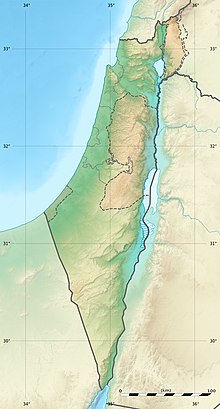Siege of Jerusalem (1244)
| Siege of Jerusalem | |||||||||
|---|---|---|---|---|---|---|---|---|---|
| Part of the Crusades | |||||||||
| |||||||||
| Belligerents | |||||||||
|
|
| ||||||||
| Commanders and leaders | |||||||||
|
| Unknown | ||||||||
| Units involved | |||||||||
|
Qaymar corps[1] Khwarazmians mercenaries | |||||||||
| Strength | |||||||||
| 10,000 | Unknown | ||||||||
| Casualties and losses | |||||||||
| Unknown | Unknown | ||||||||
| 6,000 christian civilians were masscered at the Tower of david and only 300 managed to escape to Jaffa | |||||||||
Location within Jerusalem | |||||||||
| Part of a series on |
| Jerusalem |
|---|
 |
The siege of Jerusalem of 1244 took place after the Sixth Crusade, when a Khwarazmian army conquered the city on July 15, 1244.[citation needed]
Prelude
Emperor Frederick II of the Holy Roman Empire led the Sixth Crusade from 1228 to 1229 and claimed the title of King of Jerusalem as the husband of Isabella II of Jerusalem, queen since 1212. The army brought by the emperor and his reputation in the Muslim world were enough to recover Jerusalem, Bethlehem, Nazareth and several strongholds without fighting, as signed by a treaty with the Ayyubid Sultan al-Kamil. However, Jerusalem did not remain in the hands of Christians for long, as, despite further territorial gains a few years earlier in the Barons' Crusade, the latter did not control the surroundings of the city sufficiently to be able to ensure an effective defense.
The Khwarazmian army consisted of 10,000 cavalry, comprising both some of the remnants of the predominantly Kipchak army of the last Khwarazmshah, Jalal al-Din Mangburni, and the Kurdish Qaymariyya. They were acting in concert with the Ayyubid sultan.[2]
Battle
In 1244, the Ayyubids allowed the Khwarazmians, whose empire had been destroyed by the Mongols in 1231, to attack the city. The siege took place on 15 July, and the city fell rapidly. The Khwarazmians plundered the Armenian Quarter, where they decimated the Christian population and drove out the Jews.[3] In addition, they sacked the tombs of kings of Jerusalem in the Church of the Holy Sepulchre and dug out their bones, in which the tombs of Baldwin I and Godfrey of Bouillon became cenotaphs. On 23 August, the Tower of David surrendered to the Khwarazmian forces and some 6,000 Christian men, women, and children marched out of Jerusalem [4] where they were massacred even after a promise of safe passage, only 300 would escape to Jaffa. [5]
Aftermath
The sack of the city and the massacre which accompanied it prompted the Crusaders to assemble a force to join the Ayyubid forces and fight against the Egyptian and Khwarazmian forces in the Battle of La Forbie.[6] Moreover, the events encouraged the king of France Louis IX to organize the Seventh Crusade.
References
- ^ Humphreys 1977, p. 275.
- ^ R. Stephen Humphreys (1977), From Saladin to the Mongols: The Ayyubids of Damascus, 1193–1260, State University of New York Press, p. 275.
- ^ Gilbert, Martin (1978). Jerusalem: Illustrated History Atlas, p. 25. New York: Macmillan Publishing.
- ^ Steven Runciman (1952). A History of The Crusades. Vol III: The Kingdom of Acre, p. 188. ISBN 978-0-241-29877-0.
- ^ Michael Haag (2008/2012)' 'The Templars. The History & The Myth. From Solomon's Temple to the Freemasons: A Guide to Templar History, Culture, and Locations, p 190. Published: Profile Books Ltd, 2008. The Tragedy of the Templars. The Rise and Fall of the Crusader States., p 312. Published: Profile Books Ltd, 2012.
- ^ Dougherty, Martin J. (2007). Battles of the Crusades, pp. 176–77. ISBN 978-1-905704-58-3.
Sources
- Humphreys, R. Stephen (1977). From Saladin to the Mongols: The Ayyubids of Damascus, 1193–1260. State University of New York Press.
- Satō, Tsugitaka (1986). "Iqṭāʿ Policy of Sultan Baybars I". Orient. 22: 85–104. doi:10.5356/orient1960.22.85.
External links
- The Siege on Orthodox Wiki
- The Siege on Encyclopædia Britannica
- The Siege on WZO.org, Timeline: History of Jerusalem
- The Siege on The Jewish History Resource Center

